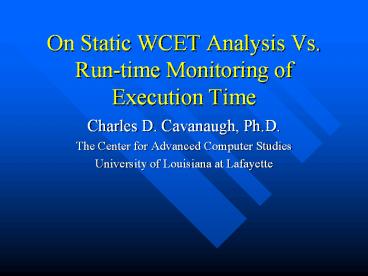On Static WCET Analysis Vs. Runtime Monitoring of Execution Time - PowerPoint PPT Presentation
1 / 15
Title:
On Static WCET Analysis Vs. Runtime Monitoring of Execution Time
Description:
On Static WCET Analysis Vs. Run-time Monitoring of Execution Time. Charles D. Cavanaugh, Ph.D. ... Computational subpath executing program ai,j,k ... – PowerPoint PPT presentation
Number of Views:56
Avg rating:3.0/5.0
Title: On Static WCET Analysis Vs. Runtime Monitoring of Execution Time
1
On Static WCET Analysis Vs. Run-time Monitoring
of Execution Time
- Charles D. Cavanaugh, Ph.D.
- The Center for Advanced Computer Studies
- University of Louisiana at Lafayette
2
Introduction
- Safety critical and mission critical software
- Input, process, output
- Ex. Air-traffic control
- Workload varies dynamically
- Can allocate resource for maximum expected input
size - Questions regarding resource allocation
- How to process more tracks than anticipated?
- How to get better utilization?
3
Example
- Air traffic control display subsystem
- R-T display of radar, correlated data
Displays
DANGER
F100 07 250 180
F100 07 250 180
747 29 400 270
747 29 400 270
S80 07 200 000
S80 07 200 000
4
(No Transcript)
5
Overview
- Model and approach
- Diagnosis algorithm
- Conclusions and future work
6
System Model and Approach
- Path d.a.g. of connected programs, Pi
- Computational subpath executing program ai,j,k
- Communication subpath connection between two
programs (ai,j,k, ai,j1,k)
7
System Model and Approach
- Observed time path or subpaths operating time
?OBS(Pi, c) - Required time specified bound on time ?REQ(Pi)
- Profiled time mean execution or communication
time with no other apps running or communicating - CPROF(ai,j,k, Pi.DS(ai,j,k, c), HOST(ai,j,k))
- CMPROF(ai,j,k, ai,j1,k, Pi.DS(ai,j,k, ai,j1,k,
c), COMMPATH(ai,j,k, ai,j1,k)) - May vary dynamically with workload
8
System Model and Approach
- Poor health path or subpaths operating time
exceeding specified bounds - ?OBS(Pi, c) exceeds ?REQ(Pi) because subpath
latencies ?OBS(ai,j,k, c) and ?OBS(ai,j,k,
ai,j1,k, c) sum to more than ?REQ(Pi) - Quality of service operating time falling
within specified bounds
9
System Model and Approach
- Workload amount of data a path or subpath
processes - Queueing delay or contention time delay caused
by other programs executing or communicating - Difference between observed time and profiled
time without contention
10
Diagnosis Algorithm
- Monitors computational and communication subpaths
- Identifies unhealthy subpaths
- Distinguishes the cause of poor health
- Recommends actions to improve health
11
Example
- Table 2. Example latency, profiled time, queuing
delay
12
Example
Table 3. Example latency, profiled time, queuing
delay
13
Conclusions and Future Work
- System model
- Observed time
- Profiled time
- Contention
- Examples
- Diagnosis algorithm
- Future work
- Incorporate into ATC simulator
- Enhance profiling accuracy
14
Diagnosis Algorithm
- (1) IF observed time gt required time THEN
- (2) IF paths maximum slack lt 0 THEN
- (3) LET s subpath having the least
maximum slack. - (4) IF s is a compuational subpath
THEN - (5) IF s is scalable THEN LET
action copy s ELSE LET action move s. - (6) IF s is a communication subpath
THEN - (7) LET action combine
endpoints of s.
15
Diagnosis Algorithm
- (8) ELSE IF paths queuing delay gt paths
maximum slack THEN - (9) LET s subpath having the least
maximum slack or the greatest queuing delay. - (10) IF s is a compuational subpath THEN
- (11) IF s has the greatest queuing delay THEN LET
action move s. - (14) IF s is a communication subpath
THEN LET action combine endpoints of s.

